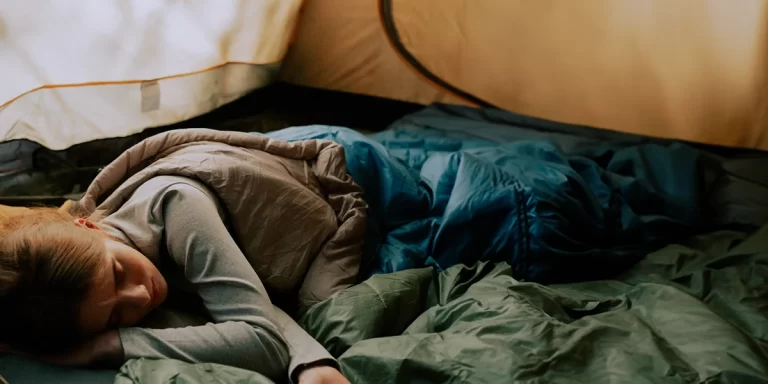

Imagine this: You’re nestled in your cozy sleeping bag, surrounded by nature’s beauty, but you can’t find that sweet spot to snooze comfortably because you’re a side sleeper. Sound familiar?
In this post, we’ll unravel side sleeper camping tips, providing both practical insights and gear recommendations to ensure a comfortable and restful night under the stars for your next camping trip.
Interested? Let’s get started.
When it comes to camping, side sleepers like you and me face a particularly challenging quest for a good night’s sleep. Here’s what we’re up against:
Now, stay with us as we explore how to combat these issues in the following sections.
Before buying any new gear, we recommend you to try a couple of things that might help:
If these tips haven’t worked for you, let’s explore some helpful gear options together.

Fortunately, you and I aren’t the last side sleepers to roam this planet, so companies are innovating around the clock to provide us with the best possible gear.
Let’s see some of the different options available.
Alongside traditional mummy bags and quilts, a game-changer for side sleepers is the ‘spoon-shaped’ sleeping bag.
While it’s challenging to trace the exact inventor of the first sleeping bag for side sleepers, but companies like Nemo Equipment, Big Agnes, and Sea to Summit popularized spoon-shaped mummy bags in the late 2000s and early 2010s.”
So, what makes these “spoon-shaped” bags special? Let’s take a closer look:
To make your life even easier, here are some popular options for spoon-shaped sleeping bags:
| Brand / Model | Weight (g) |
|---|---|
| Big Agnes Sidewinder SL 20° | 2 lb 4 oz (1020) |
| Nemo Disco 30 | 2 lb 11 oz (1220) |
| REI Co-op Siesta Hooded 20 | 5 lb 5 oz (2400) |
| Sierra Designs Night Cap 35° | 2 lb 3.7 oz (1011) |
No side sleeper’s sleep setup is complete without a quality sleeping pad. Now, let’s explore what you should look for when choosing one:
To simplify your choices, here are some top picks for camping sleeping pads tailored to side sleepers:
| Brand / Model | Weight (g) |
|---|---|
| Sea to Summit Ether Light XT (Regular Wide) | 1 lb 6 oz (630) |
| Nemo Tensor Insulated (Regular Wide) | 1 lb 6 oz (630) |
| Big Agnes Zoom UL Insulated (25″ x 72″) | 1 lb 1 oz (480) |
| Therm-a-Rest NeoAir® XLite™ NXT Sleeping Pad (Regular Wide) | 1 lb (450) |
Sleeping accessories are vital for a comfortable camping experience as a side sleeper. Let’s delve into essential accessories for side sleepers:
Here are some recommended backpacking camping pillows designed specifically for side sleepers:
| Brand / Model | Weight oz (g) |
|---|---|
| Exped MegaPillow | 6 (170) |
| Sea to Summit Aeros Down Pillow | 2.5 (70) |
| Nemo Equipment Fillo Elite Ultralight Backpacking Pillow | 2.8 (80) |
Side sleeping while camping is achievable with the right camping equipment.
These camping essentials include spoon-shaped bags, wide pads, and adjustable pillows for optimal support. Finding your perfect combination may require some testing, but small adjustments can significantly enhance your sleep.
Use these tips to prepare effectively, and then relax, knowing you’re ready to rest up for your next camping adventure. Sleep well!
Pack an inflatable pillow you can adjust by adding or removing breaths. Use a fleece jacket or blanket rolled to different thicknesses as a pillow behind your head and knees. Take a folded sit pad for lumbar support inside your bag. Cut pool noodles in half lengthwise to cushion under knees. Test diagonal pad placement for better hip alignment. Attach guylines outside your tent to customize side “room.” Wear base layers as PJs to avoid bag constriction. Bring a small towel under your ear or store a hot water bottle by your feet for extra comfort. Pack lightweight shoes as leg/neck supports in a pinch. Lean your pad against the tent wall for back support. Wiggle your bag all the way down at the foot end for maximum curled-up space.
For side sleepers, the best shape for a sleeping bag is often the “spoon-shaped” design. Spoon-shaped sleeping bags offer extra room around the hips and knees, allowing side sleepers to comfortably curl up and move around within the bag. This design strikes a balance between the heat retention of a mummy bag and the freedom of movement side sleepers need. Brands like Nemo, Big Agnes, and Sea to Summit offer excellent options in this category. Ultimately, the ideal shape may vary based on personal preference, but spoon-shaped bags are a popular choice for side sleepers seeking both camping comfort and warmth.
Sleeping on your side while camping can be comfortable with the right gear and technique. First, choose a sleeping bag designed for side sleepers, like a “spoon-shaped” bag, which offers extra room around the hips and knees. Use a supportive pillow that keeps your head at a level plane to the ground. Consider a sleeping bag liner for added comfort and temperature regulation. To maximize comfort, adjust within the bag or roll inside it to find your preferred sleeping position.
When you are outdoors, look for a flat, level area with firm, packed ground to avoid rolling downhill or discomfort from soft surfaces. Aim for a sheltered location with dense tree coverage to block wind yet far enough from noisy trails, streams, and groups. Orient your tent sideways with your feet pointed downhill and head away from sounds. Stage essentials within easy reach so you don’t have to fully exit your bag at night. Also, choose a well-drained, higher site if needing bug protection.